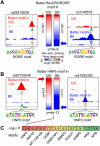GENE REGULATION. Discrete functions of nuclear receptor Rev-erbα couple metabolism to the clock
- PMID: 26044300
- PMCID: PMC4613749
- DOI: 10.1126/science.aab3021
GENE REGULATION. Discrete functions of nuclear receptor Rev-erbα couple metabolism to the clock
Abstract
Circadian and metabolic physiology are intricately intertwined, as illustrated by Rev-erbα, a transcription factor (TF) that functions both as a core repressive component of the cell-autonomous clock and as a regulator of metabolic genes. Here, we show that Rev-erbα modulates the clock and metabolism by different genomic mechanisms. Clock control requires Rev-erbα to bind directly to the genome at its cognate sites, where it competes with activating ROR TFs. By contrast, Rev-erbα regulates metabolic genes primarily by recruiting the HDAC3 co-repressor to sites to which it is tethered by cell type-specific transcription factors. Thus, direct competition between Rev-erbα and ROR TFs provides a universal mechanism for self-sustained control of the molecular clock across all tissues, whereas Rev-erbα uses lineage-determining factors to convey a tissue-specific epigenomic rhythm that regulates metabolism tailored to the specific need of that tissue.
Copyright © 2015, American Association for the Advancement of Science.
Figures




Comment in
-
Segregation of Clock and Non-Clock Regulatory Functions of REV-ERB.Cell Metab. 2015 Aug 4;22(2):197-8. doi: 10.1016/j.cmet.2015.07.014. Cell Metab. 2015. PMID: 26244927 Free PMC article.
References
-
- Asher G, Sassone-Corsi P. Time for food: The intimate interplay between nutrition, metabolism, and the circadian clock. Cell. 2015;161:84–92. - PubMed
Publication types
MeSH terms
Substances
Associated data
- Actions
Grants and funding
- R01 DK045586/DK/NIDDK NIH HHS/United States
- F30 DK104513/DK/NIDDK NIH HHS/United States
- P30 DK050306/DK/NIDDK NIH HHS/United States
- K08 DK094968/DK/NIDDK NIH HHS/United States
- R01 DK45586/DK/NIDDK NIH HHS/United States
- F32 DK102284/DK/NIDDK NIH HHS/United States
- R01 DK098542/DK/NIDDK NIH HHS/United States
- T32 GM0008275/GM/NIGMS NIH HHS/United States
- R00 DK099443/DK/NIDDK NIH HHS/United States
- P30 DK019525/DK/NIDDK NIH HHS/United States
- T32 GM008275/GM/NIGMS NIH HHS/United States
- P30 DK19525/DK/NIDDK NIH HHS/United States
LinkOut - more resources
Full Text Sources
Other Literature Sources
Molecular Biology Databases
Miscellaneous

